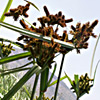Cyperus dives is a very tall perennial herbaceous plant (1.50 to 2.50 m). It is very similar to Cyperus alopecuroides. The leaves are concentrated at the base of the plant, and the flower spike is leafless and does not branch. Only at the head of the spike, around the inflorescence, do bracts envelop it, like an additional wreath of leaves.
Cyperus dives blooms for a long time, from April to September. Its inflorescence is beautiful and rich. The spikes are thick and dense, and are composed of elongated spikelets that are 1 to 1.5 mm wide. The glumes are imbricate, dense. There are 3 stigmata. The involucres are much longer than the inflorescence. Cyperus dives grows on river banks and marshes in the northern Coastal Plain and in the northern Jordan Rift Valley. Its global distribution spreads around tropical regions.
Cyperus (Reeds) is a huge genus, which includes 300 plant species (some claim 600 or even 700), which are common in all continents, in tropical and subtropical regions. The leaves extend from the base of the plant, their blades are linear, and the sheath is a closed tube. The plant has a stem (which is not considered to be a culm, because it is not hollow, and this differentiates the Cyperaceae from the Gramineae, which are similar but their stem is hollow), and the head of the stem carries a single inflorescence in the shape of an umbel or capitulum. The stem is not divided into nodes, it is leafless, and it is usually ribbed, with 3 sides. The inflorescence is enveloped by leaf-like bracts and has several spikes, where each is composed of compressed spikelets, and each spikelet contains numerous flowers. The spikelet lemmas are arranged in two imbricate opposite rows. The flower is small, and lacks a perianth. It is not colorful. Each flower has 3 long weak stamens (sometimes 1 or 2) as usual in flowers that are pollinated by wind. It has a style with 2 or 3 stigmata, usually curled. The fruit is a single-seed nutlet. Most Reed species are found in humid habitats, and are herbaceous water plants with thickened rhizomes or bulbs. The rhizome serves the plant for vegetative reproduction. In some species the rhizome or bulb is used by humans as a source for edible carbohydrates or for medicinal substances. Other species are cultivated in gardens as ornamental plants. The most familiar Reed species are Cyperus papyrus (Nile papyrus, Paper Reed), which was used by the ancients to make paper, and Cyperus rotundus (Nutgrass), which is sometimes considered the most harmful weed in the world. Twenty two different species of Reed grow in Israel, many of which are rare and on the verge of extinction, because the habitats of fresh water are endangered around the entire globe, and especially in Israel, due to drying and draining, depletion of water sources, overuse and pollution.
The Cyperaceae family includes 3,000 species in 85 genera. In Israel there are representatives of 8 genera.
Written by Mike Livne




